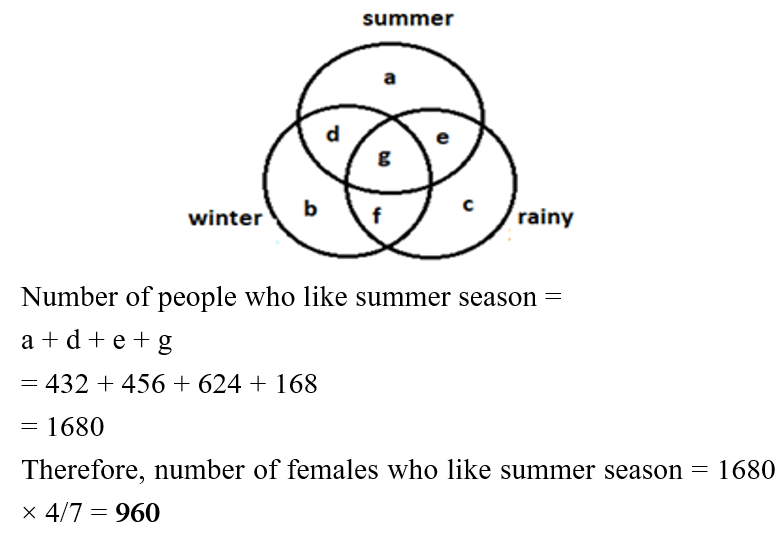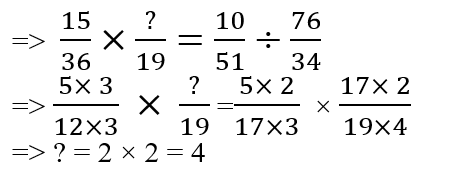Question 1:
Directions: Study the following information carefully and answer the related questions.
निर्देश: निम्नलिखित सूचना का सावधानीपूर्वक अध्ययन कीजिए और सम्बन्धित प्रश्नों के उत्तर दीजिए।
There are 2400 people in a town and each person like at least one season among three seasons (summer, winter and rainy season). 30% people do not like summer season and 168 people like all three seasons. 54% people like winter season and 48 people like only rainy season. People who like rainy season are 96 more than number of people who like winter season. 26% people like both summer and rainy season but not winter season.
एक शहर में 2,400 व्यक्ति हैं और प्रत्येक व्यक्ति को तीन मौसमों (गर्मी, सर्दी और बरसात के मौसम) में से न्यूनतम एक मौसम पसंद है। 30% व्यक्तियों को गर्मी का मौसम पसंद नहीं है और 168 व्यक्तियों को तीनों मौसम पसंद हैं। 54% व्यक्तियों को सर्दी का मौसम पसंद है और 48 व्यक्तियों को केवल बरसात का मौसम पसंद है। बरसात का मौसम को पसंद करने वाले व्यक्ति, सर्दी के मौसम को पसंद करने वालों व्यक्तियों की संख्या से 96 अधिक हैं। 26% व्यक्तियों को गर्मी और बरसात दोनों मौसम पसंद हैं, लेकिन सर्दी का मौसम पसन्द नहीं है।
If ratio of female to male population who like summer season is 4: 3 respectively, then how many females like summer season?
यदि गर्मी के मौसम को पसंद करने वाली महिला जनसंख्या और गर्मी के मौसम को पसंद करने वाले पुरुष जनसंख्या का अनुपात क्रमशः 4 : 3 है, तब गर्मियों के मौसम को कितनी महिलाएँ पसन्द करती हैं?
Question 2: 
Question 3: 
Question 4:
A 450-metre-long train running at a speed of 38 km/hr crosses a man running at a speed of 8 km/hr in the same direction in 'T' seconds. Find the value of 'Y' if difference between 'T' and 'Y' is 4.
38 km/hr की चाल से चल रही 450 मीटर लंबी ट्रेन समान दिशा में 8 km/hr की चाल से दौड़ रहे एक व्यक्ति को 'T' सेकंड में पार करती है। यदि 'T' और 'Y' के बीच का अंतर 4 है, तो 'Y' का मान ज्ञात कीजिए।
Question 5:
The number of years P is older than Q is the same as Q is older than R. Sum of present ages of P and R is 56 years. What is the present age of Q?
P, Q से जितने वर्ष बड़ा है, उतने ही वर्ष हैं जितने वर्ष Q, R से बड़ा है। P और R की वर्तमान आयु का योग 56 वर्ष है। Q की वर्तमान आयु क्या है?
Question 6:
The diameter of a circular park is 28 m and a path of 7 m is running around the circular park, what is the total cost of flooring of the path at the rate of Rs. 5 per square meter?
एक वृत्ताकार उद्यान का व्यास 28 मी है और वृत्ताकार उद्यान के चारों ओर 7 मी का मार्ग है, 5 रुपये प्रति वर्ग मीटर की दर से मार्ग को फर्श कराने की कुल लागत कितनी है?
Question 7:
Rohit got 80 marks in English, 78 marks in science, 82 marks in Hindi, 98 marks in Math and 65 marks in History. What is the approximate percentage of marks obtained by Rohit overall in the examination if the maximum marks in each subject is 100.
रोहित को इंग्लिश में 80 अंक, साइंस में 78 अंक, हिंदी में 82 अंक, मैथ में 98 अंक और हिस्ट्री में 65 अंक प्राप्त हुए। यदि प्रत्येक विषय में अधिकतम अंक 100 हैं, तो रोहित द्वारा परीक्षा में कुल प्राप्त अंकों का अनुमानित प्रतिशत कितना है?
Question 8:
Area of two rectangles A and B are in the ratio 3: 4 respectively. Sides of rectangle A are in the ratio 3: 1 respectively and perimeter of rectangle B is 50 cm and its breadth is 5 cm. What is the perimeter of rectangle A?
दो आयत A और B के क्षेत्रफल का अनुपात क्रमशः 3: 4 है।आयत A की भुजाओं का अनुपात क्रमशः 3: 1 हैं और आयत B का परिमाप 50 सेमी है और इसकी चौड़ाई 5 सेमी है। आयत A का परिमाप कितना है?
Question 9:
In a drawer, there are three coloured napkins (white, pink, and yellow) in the ratio of 5: 8: 13 respectively. If number of pink napkins are 30 less than the total number of white and yellow napkins, then how many total napkins are there in the drawer?
एक दराज में क्रमश: 5: 8:13 के अनुपात में तीन रंगीन नैपकिन (वाइट, पिंक और येलो) हैं। यदि पिंक नैपकिन की संख्या, वाइट और येलो नैपकिन की कुल संख्या से 30 कम है, तो दराज में कुल कितने नैपकिन हैं?
Question 10:
On increasing the numerator of a fraction by 33(1/3) % and decreasing the denominator by 20%, the resultant fraction becomes 10/9. Find the original fraction.
एक भिन्न के अंश में 33(1/3)% की वृद्धि तथा हर में 20% की कमी करने पर परिणामी भिन्न 10/9 हो जाती है, तो मूल भिन्न ज्ञात कीजिए।





